COR167e Managing Your Personal Finances - Wealth and Estate Plan
VerifiedAdded on 2023/06/13
|12
|2448
|194
Case Study
AI Summary
This assignment presents a detailed case study of Amanda Li, focusing on various aspects of personal finance. It covers wealth protection through tax planning, examining the taxability of different income sources like director's fees, modeling income, lecturing income, and lottery winnings. The assignment also computes Amanda's tax liabilities for royalty income and determines her income from two properties. Furthermore, it calculates the share option benefit assessable on Amanda. The second part delves into wealth accumulation and retirement planning, discussing Advance Medical Directives (AMD), their revocation, and circumstances under which a doctor certifies terminal illness. It also determines Amanda's contribution to her Supplementary Retirement Scheme Account and the amount she can use to top up Sandra's CPF Account, listing options to bridge the retirement shortfall. Finally, the assignment addresses wealth giving and estate planning, clarifying the difference between trust and will, the validity and review of Amanda's will after marriage, and advising on the most effective ways of planning her estates, including her Pine Grove property, Whole Life Insurance Policy proceeds, and savings/fixed deposit amounts for charity. This document is available on Desklib, where students can find similar resources and solved assignments.
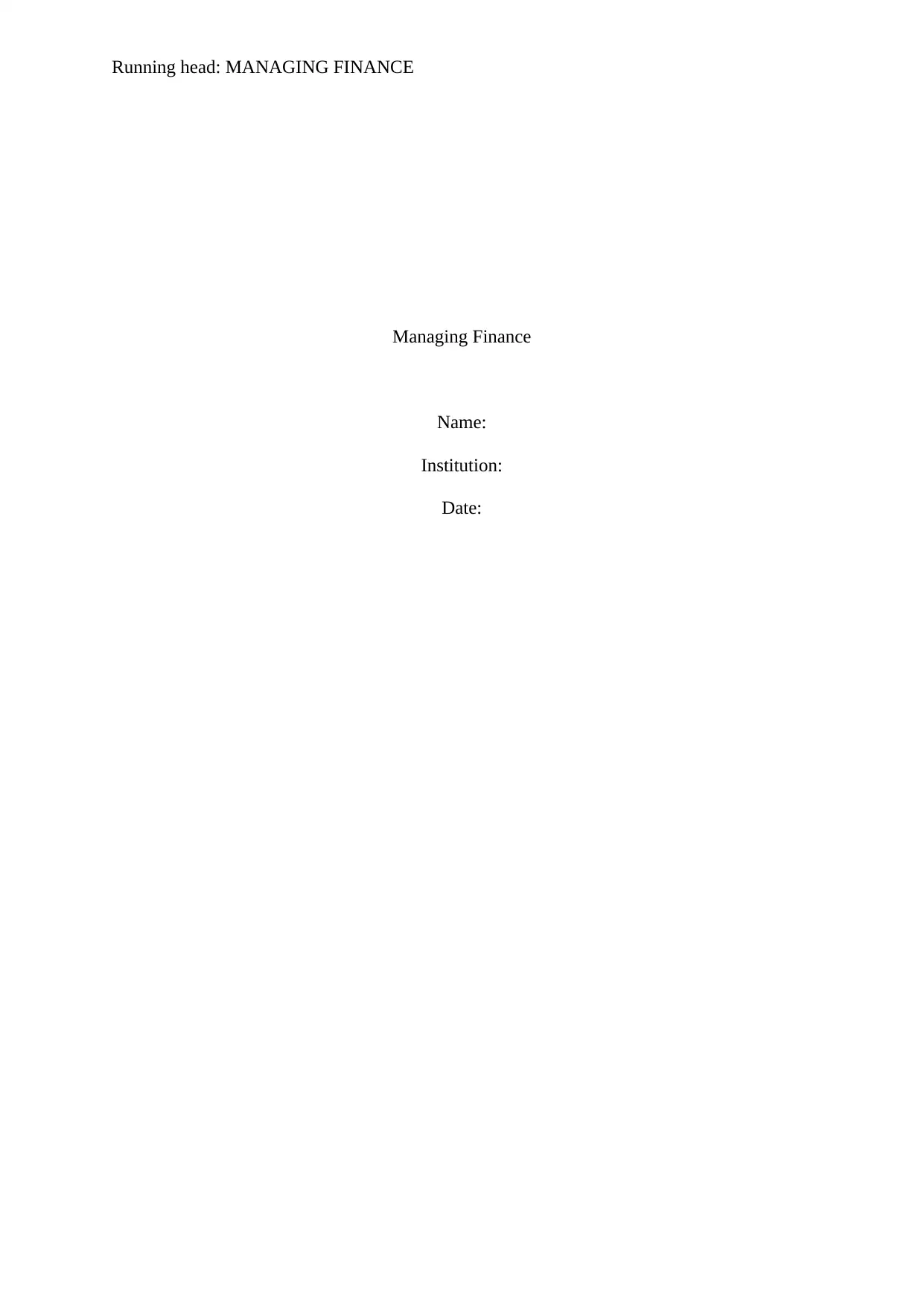
Running head: MANAGING FINANCE
Managing Finance
Name:
Institution:
Date:
Managing Finance
Name:
Institution:
Date:
Secure Best Marks with AI Grader
Need help grading? Try our AI Grader for instant feedback on your assignments.
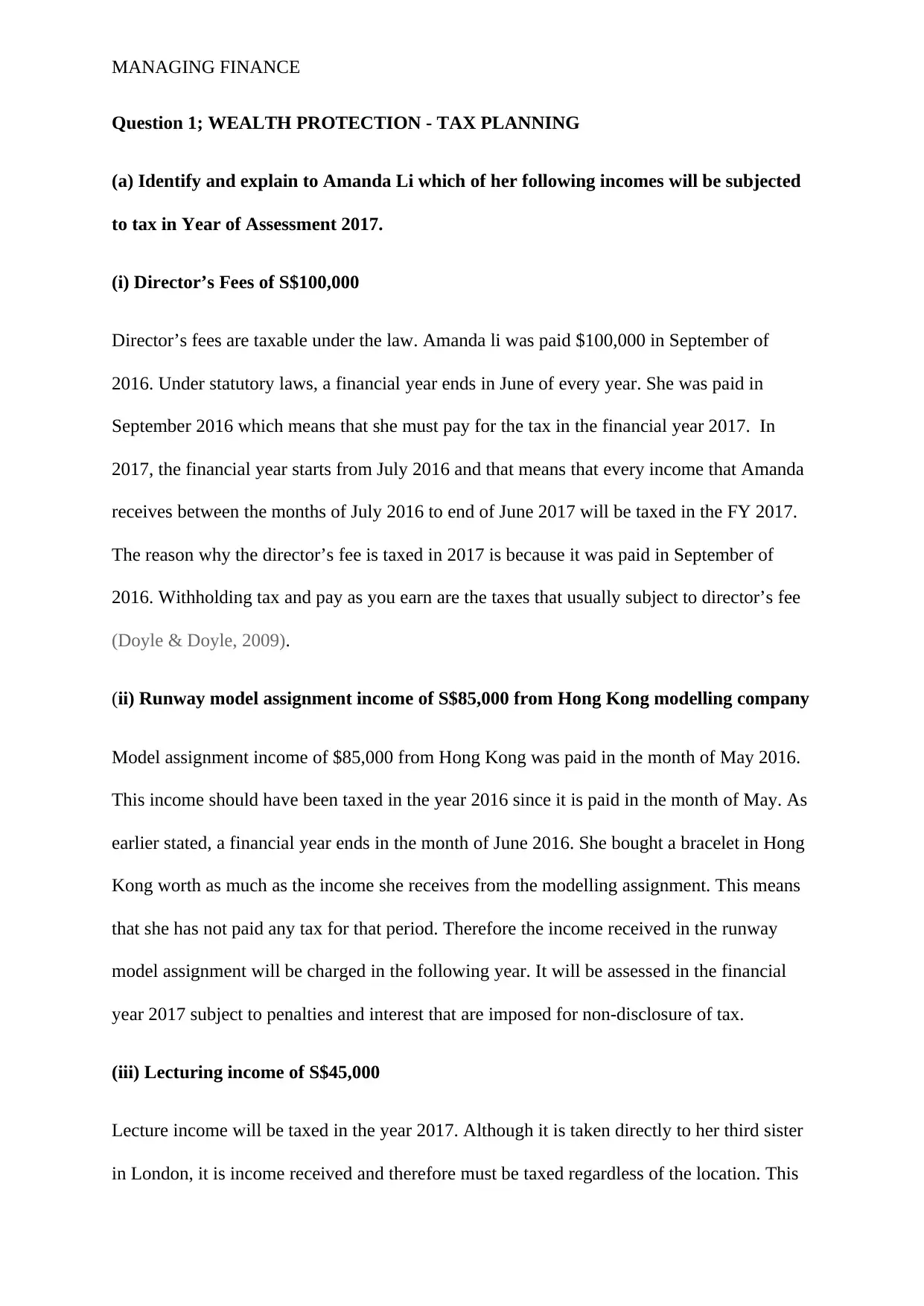
MANAGING FINANCE
Question 1; WEALTH PROTECTION - TAX PLANNING
(a) Identify and explain to Amanda Li which of her following incomes will be subjected
to tax in Year of Assessment 2017.
(i) Director’s Fees of S$100,000
Director’s fees are taxable under the law. Amanda li was paid $100,000 in September of
2016. Under statutory laws, a financial year ends in June of every year. She was paid in
September 2016 which means that she must pay for the tax in the financial year 2017. In
2017, the financial year starts from July 2016 and that means that every income that Amanda
receives between the months of July 2016 to end of June 2017 will be taxed in the FY 2017.
The reason why the director’s fee is taxed in 2017 is because it was paid in September of
2016. Withholding tax and pay as you earn are the taxes that usually subject to director’s fee
(Doyle & Doyle, 2009).
(ii) Runway model assignment income of S$85,000 from Hong Kong modelling company
Model assignment income of $85,000 from Hong Kong was paid in the month of May 2016.
This income should have been taxed in the year 2016 since it is paid in the month of May. As
earlier stated, a financial year ends in the month of June 2016. She bought a bracelet in Hong
Kong worth as much as the income she receives from the modelling assignment. This means
that she has not paid any tax for that period. Therefore the income received in the runway
model assignment will be charged in the following year. It will be assessed in the financial
year 2017 subject to penalties and interest that are imposed for non-disclosure of tax.
(iii) Lecturing income of S$45,000
Lecture income will be taxed in the year 2017. Although it is taken directly to her third sister
in London, it is income received and therefore must be taxed regardless of the location. This
Question 1; WEALTH PROTECTION - TAX PLANNING
(a) Identify and explain to Amanda Li which of her following incomes will be subjected
to tax in Year of Assessment 2017.
(i) Director’s Fees of S$100,000
Director’s fees are taxable under the law. Amanda li was paid $100,000 in September of
2016. Under statutory laws, a financial year ends in June of every year. She was paid in
September 2016 which means that she must pay for the tax in the financial year 2017. In
2017, the financial year starts from July 2016 and that means that every income that Amanda
receives between the months of July 2016 to end of June 2017 will be taxed in the FY 2017.
The reason why the director’s fee is taxed in 2017 is because it was paid in September of
2016. Withholding tax and pay as you earn are the taxes that usually subject to director’s fee
(Doyle & Doyle, 2009).
(ii) Runway model assignment income of S$85,000 from Hong Kong modelling company
Model assignment income of $85,000 from Hong Kong was paid in the month of May 2016.
This income should have been taxed in the year 2016 since it is paid in the month of May. As
earlier stated, a financial year ends in the month of June 2016. She bought a bracelet in Hong
Kong worth as much as the income she receives from the modelling assignment. This means
that she has not paid any tax for that period. Therefore the income received in the runway
model assignment will be charged in the following year. It will be assessed in the financial
year 2017 subject to penalties and interest that are imposed for non-disclosure of tax.
(iii) Lecturing income of S$45,000
Lecture income will be taxed in the year 2017. Although it is taken directly to her third sister
in London, it is income received and therefore must be taxed regardless of the location. This
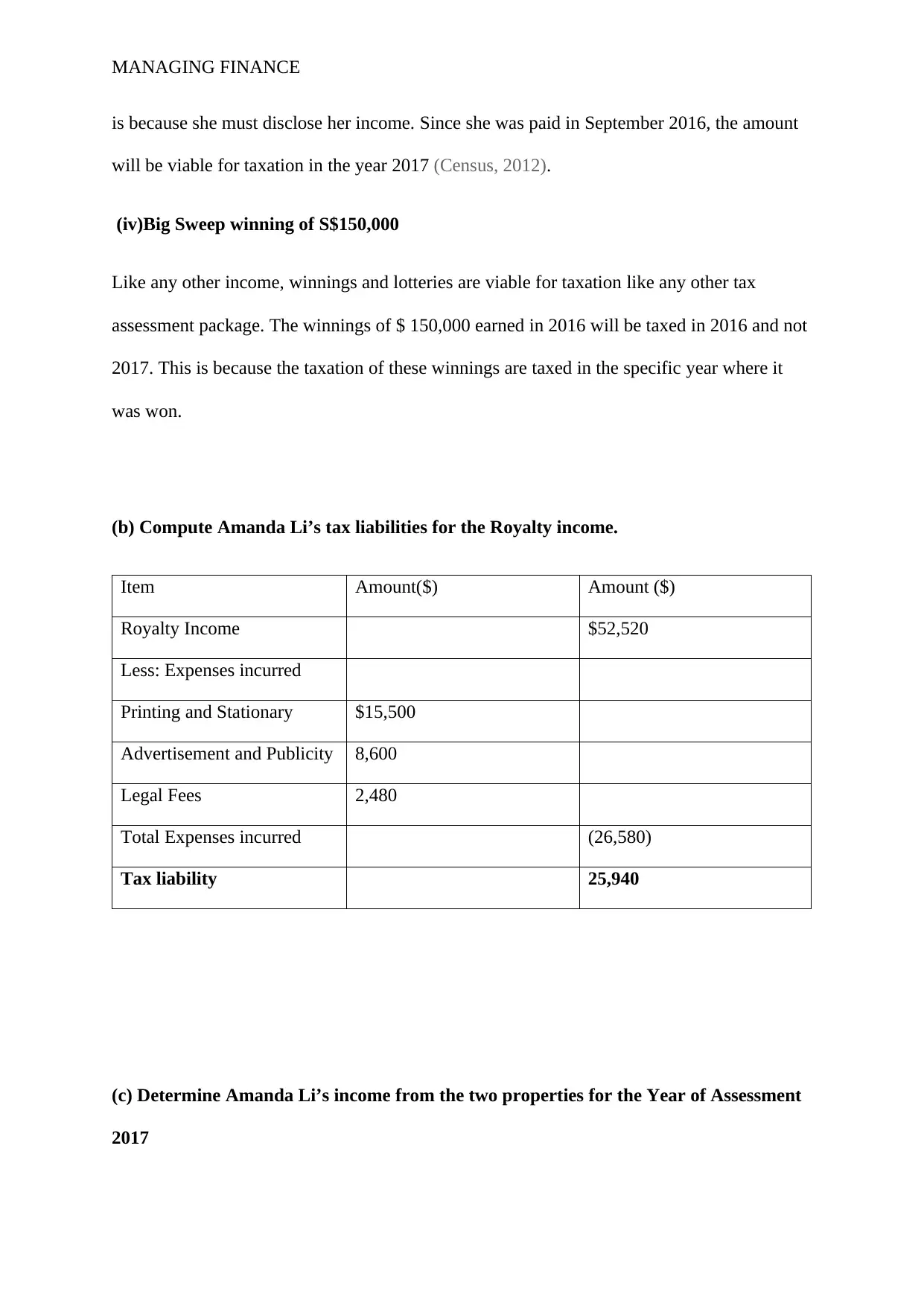
MANAGING FINANCE
is because she must disclose her income. Since she was paid in September 2016, the amount
will be viable for taxation in the year 2017 (Census, 2012).
(iv)Big Sweep winning of S$150,000
Like any other income, winnings and lotteries are viable for taxation like any other tax
assessment package. The winnings of $ 150,000 earned in 2016 will be taxed in 2016 and not
2017. This is because the taxation of these winnings are taxed in the specific year where it
was won.
(b) Compute Amanda Li’s tax liabilities for the Royalty income.
Item Amount($) Amount ($)
Royalty Income $52,520
Less: Expenses incurred
Printing and Stationary $15,500
Advertisement and Publicity 8,600
Legal Fees 2,480
Total Expenses incurred (26,580)
Tax liability 25,940
(c) Determine Amanda Li’s income from the two properties for the Year of Assessment
2017
is because she must disclose her income. Since she was paid in September 2016, the amount
will be viable for taxation in the year 2017 (Census, 2012).
(iv)Big Sweep winning of S$150,000
Like any other income, winnings and lotteries are viable for taxation like any other tax
assessment package. The winnings of $ 150,000 earned in 2016 will be taxed in 2016 and not
2017. This is because the taxation of these winnings are taxed in the specific year where it
was won.
(b) Compute Amanda Li’s tax liabilities for the Royalty income.
Item Amount($) Amount ($)
Royalty Income $52,520
Less: Expenses incurred
Printing and Stationary $15,500
Advertisement and Publicity 8,600
Legal Fees 2,480
Total Expenses incurred (26,580)
Tax liability 25,940
(c) Determine Amanda Li’s income from the two properties for the Year of Assessment
2017
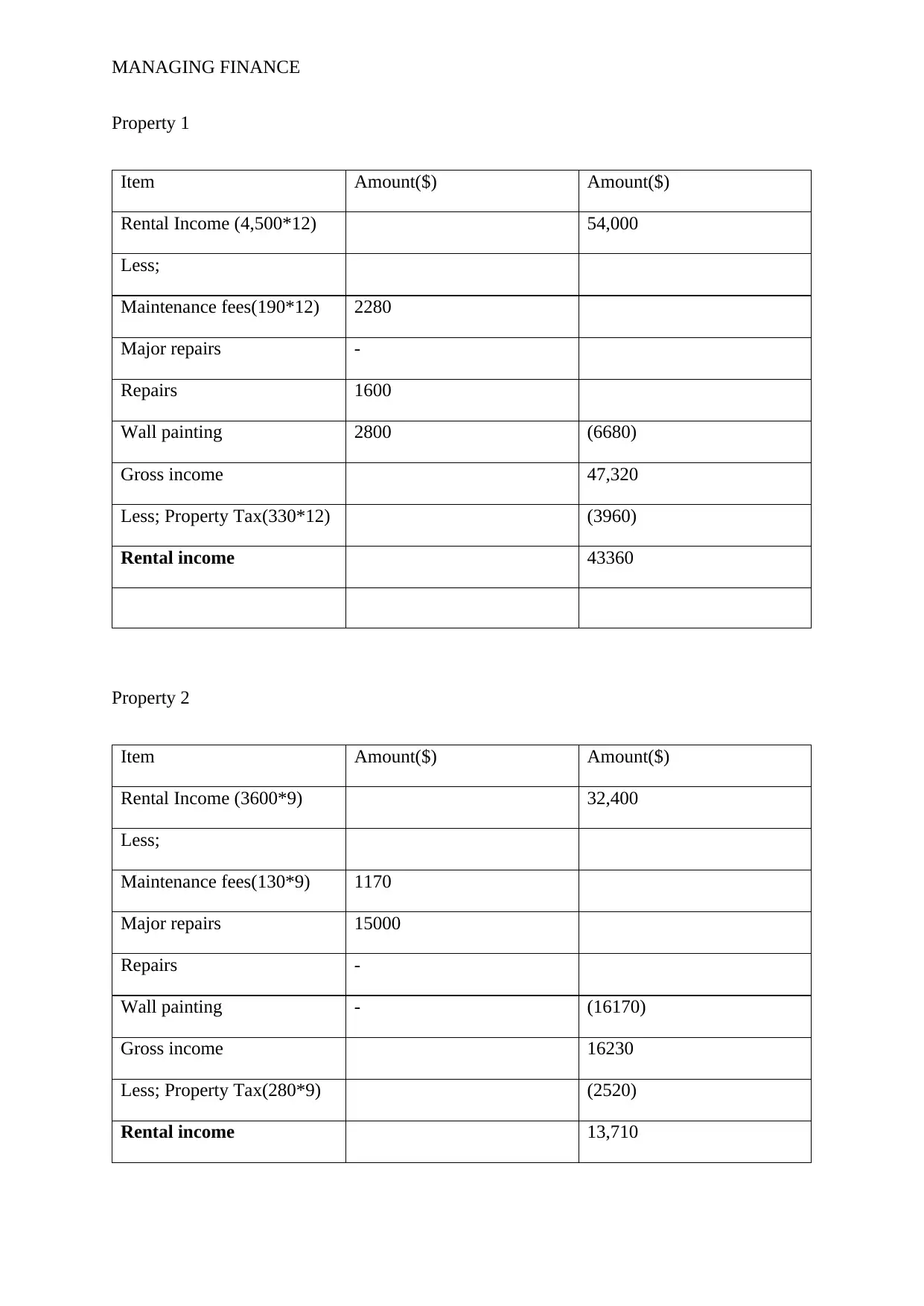
MANAGING FINANCE
Property 1
Item Amount($) Amount($)
Rental Income (4,500*12) 54,000
Less;
Maintenance fees(190*12) 2280
Major repairs -
Repairs 1600
Wall painting 2800 (6680)
Gross income 47,320
Less; Property Tax(330*12) (3960)
Rental income 43360
Property 2
Item Amount($) Amount($)
Rental Income (3600*9) 32,400
Less;
Maintenance fees(130*9) 1170
Major repairs 15000
Repairs -
Wall painting - (16170)
Gross income 16230
Less; Property Tax(280*9) (2520)
Rental income 13,710
Property 1
Item Amount($) Amount($)
Rental Income (4,500*12) 54,000
Less;
Maintenance fees(190*12) 2280
Major repairs -
Repairs 1600
Wall painting 2800 (6680)
Gross income 47,320
Less; Property Tax(330*12) (3960)
Rental income 43360
Property 2
Item Amount($) Amount($)
Rental Income (3600*9) 32,400
Less;
Maintenance fees(130*9) 1170
Major repairs 15000
Repairs -
Wall painting - (16170)
Gross income 16230
Less; Property Tax(280*9) (2520)
Rental income 13,710
Secure Best Marks with AI Grader
Need help grading? Try our AI Grader for instant feedback on your assignments.
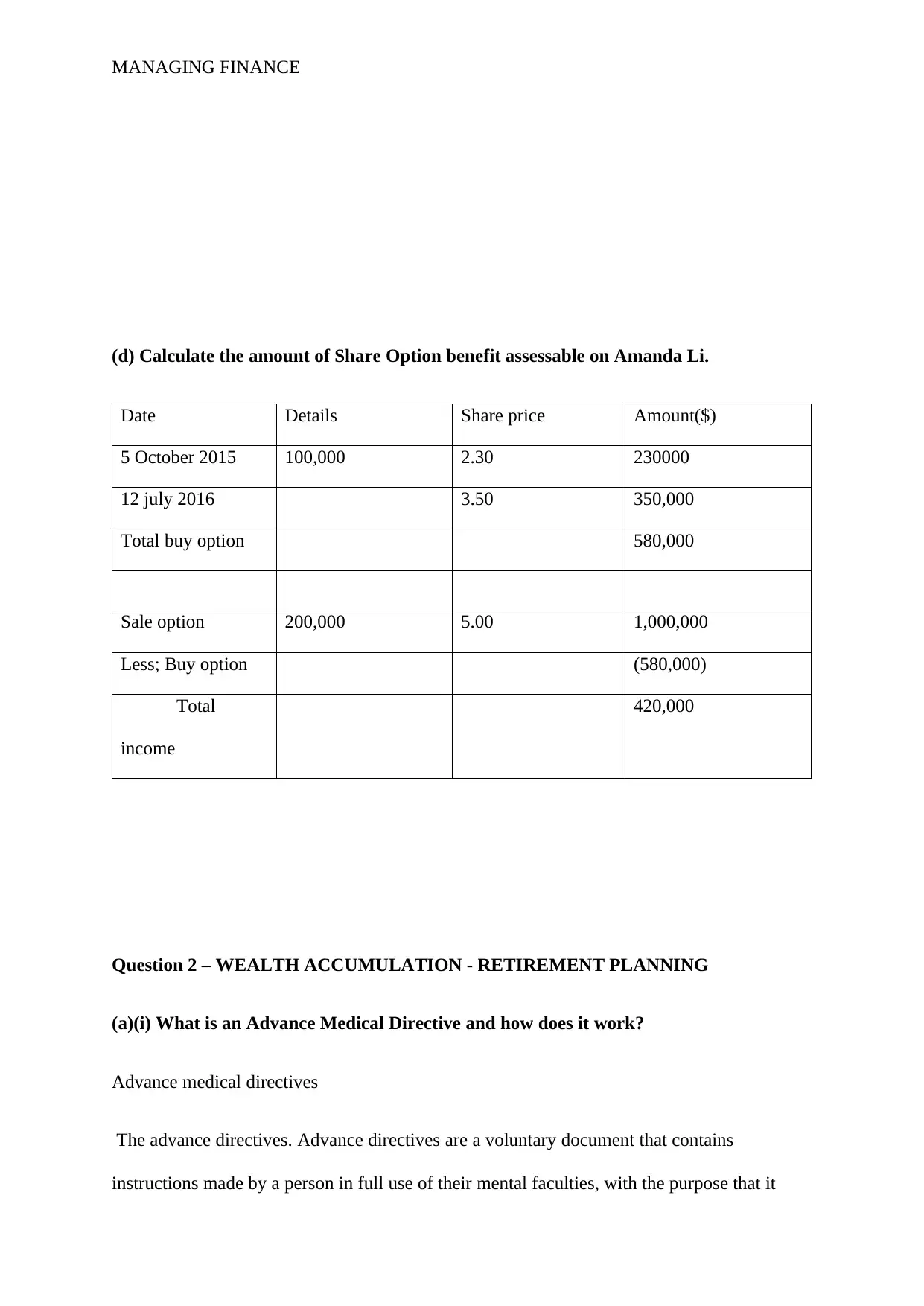
MANAGING FINANCE
(d) Calculate the amount of Share Option benefit assessable on Amanda Li.
Date Details Share price Amount($)
5 October 2015 100,000 2.30 230000
12 july 2016 3.50 350,000
Total buy option 580,000
Sale option 200,000 5.00 1,000,000
Less; Buy option (580,000)
Total
income
420,000
Question 2 – WEALTH ACCUMULATION - RETIREMENT PLANNING
(a)(i) What is an Advance Medical Directive and how does it work?
Advance medical directives
The advance directives. Advance directives are a voluntary document that contains
instructions made by a person in full use of their mental faculties, with the purpose that it
(d) Calculate the amount of Share Option benefit assessable on Amanda Li.
Date Details Share price Amount($)
5 October 2015 100,000 2.30 230000
12 july 2016 3.50 350,000
Total buy option 580,000
Sale option 200,000 5.00 1,000,000
Less; Buy option (580,000)
Total
income
420,000
Question 2 – WEALTH ACCUMULATION - RETIREMENT PLANNING
(a)(i) What is an Advance Medical Directive and how does it work?
Advance medical directives
The advance directives. Advance directives are a voluntary document that contains
instructions made by a person in full use of their mental faculties, with the purpose that it
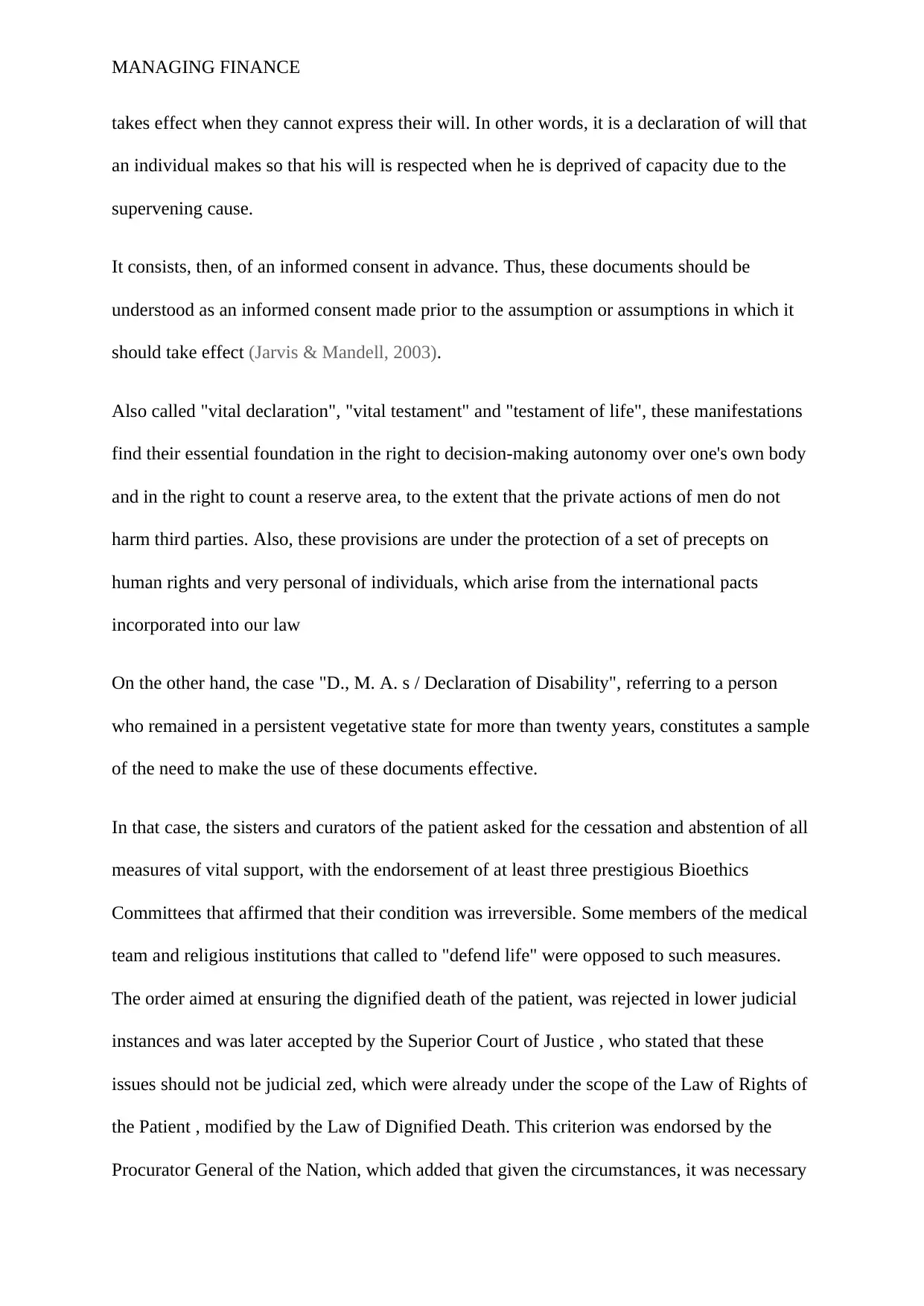
MANAGING FINANCE
takes effect when they cannot express their will. In other words, it is a declaration of will that
an individual makes so that his will is respected when he is deprived of capacity due to the
supervening cause.
It consists, then, of an informed consent in advance. Thus, these documents should be
understood as an informed consent made prior to the assumption or assumptions in which it
should take effect (Jarvis & Mandell, 2003).
Also called "vital declaration", "vital testament" and "testament of life", these manifestations
find their essential foundation in the right to decision-making autonomy over one's own body
and in the right to count a reserve area, to the extent that the private actions of men do not
harm third parties. Also, these provisions are under the protection of a set of precepts on
human rights and very personal of individuals, which arise from the international pacts
incorporated into our law
On the other hand, the case "D., M. A. s / Declaration of Disability", referring to a person
who remained in a persistent vegetative state for more than twenty years, constitutes a sample
of the need to make the use of these documents effective.
In that case, the sisters and curators of the patient asked for the cessation and abstention of all
measures of vital support, with the endorsement of at least three prestigious Bioethics
Committees that affirmed that their condition was irreversible. Some members of the medical
team and religious institutions that called to "defend life" were opposed to such measures.
The order aimed at ensuring the dignified death of the patient, was rejected in lower judicial
instances and was later accepted by the Superior Court of Justice , who stated that these
issues should not be judicial zed, which were already under the scope of the Law of Rights of
the Patient , modified by the Law of Dignified Death. This criterion was endorsed by the
Procurator General of the Nation, which added that given the circumstances, it was necessary
takes effect when they cannot express their will. In other words, it is a declaration of will that
an individual makes so that his will is respected when he is deprived of capacity due to the
supervening cause.
It consists, then, of an informed consent in advance. Thus, these documents should be
understood as an informed consent made prior to the assumption or assumptions in which it
should take effect (Jarvis & Mandell, 2003).
Also called "vital declaration", "vital testament" and "testament of life", these manifestations
find their essential foundation in the right to decision-making autonomy over one's own body
and in the right to count a reserve area, to the extent that the private actions of men do not
harm third parties. Also, these provisions are under the protection of a set of precepts on
human rights and very personal of individuals, which arise from the international pacts
incorporated into our law
On the other hand, the case "D., M. A. s / Declaration of Disability", referring to a person
who remained in a persistent vegetative state for more than twenty years, constitutes a sample
of the need to make the use of these documents effective.
In that case, the sisters and curators of the patient asked for the cessation and abstention of all
measures of vital support, with the endorsement of at least three prestigious Bioethics
Committees that affirmed that their condition was irreversible. Some members of the medical
team and religious institutions that called to "defend life" were opposed to such measures.
The order aimed at ensuring the dignified death of the patient, was rejected in lower judicial
instances and was later accepted by the Superior Court of Justice , who stated that these
issues should not be judicial zed, which were already under the scope of the Law of Rights of
the Patient , modified by the Law of Dignified Death. This criterion was endorsed by the
Procurator General of the Nation, which added that given the circumstances, it was necessary
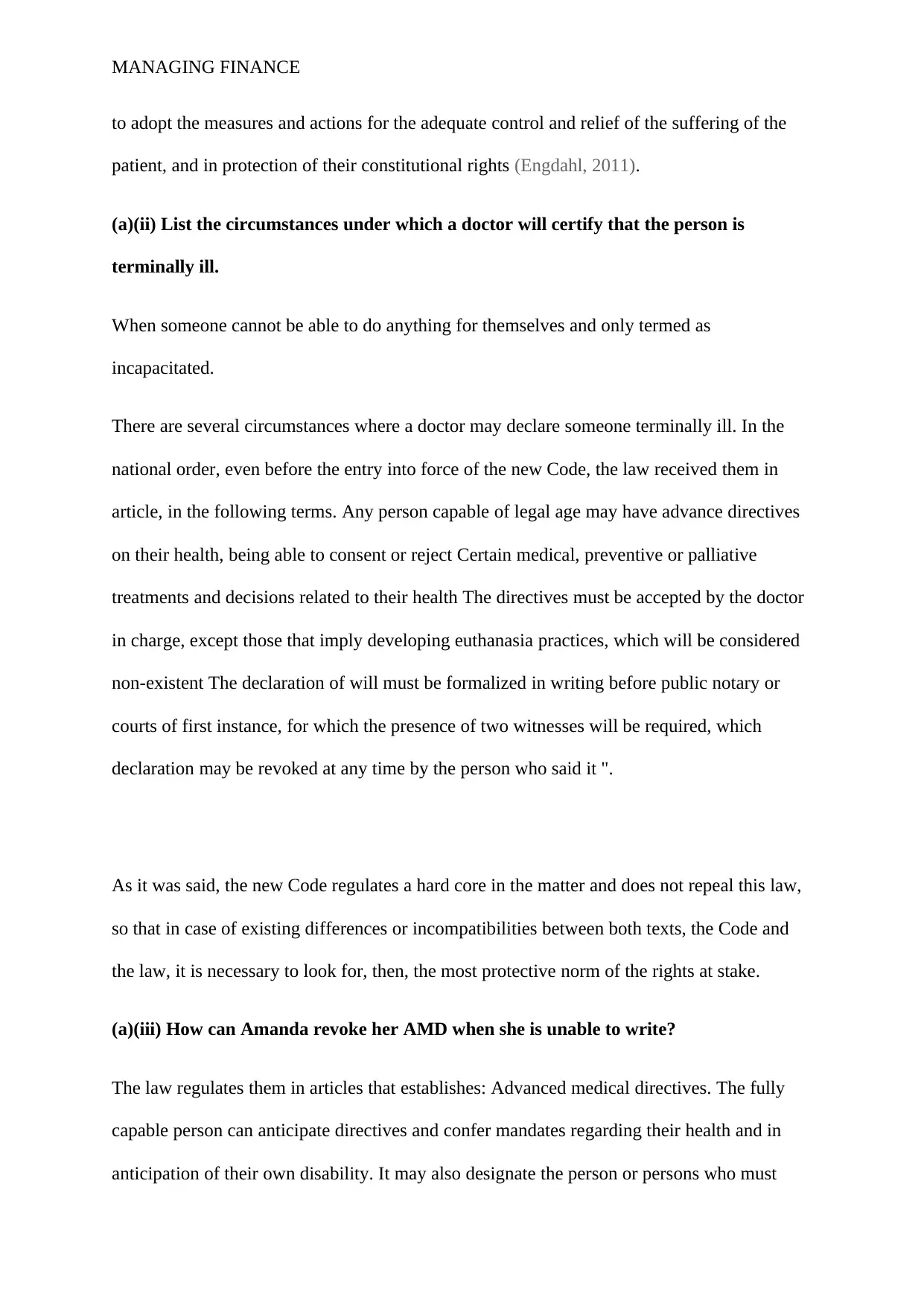
MANAGING FINANCE
to adopt the measures and actions for the adequate control and relief of the suffering of the
patient, and in protection of their constitutional rights (Engdahl, 2011).
(a)(ii) List the circumstances under which a doctor will certify that the person is
terminally ill.
When someone cannot be able to do anything for themselves and only termed as
incapacitated.
There are several circumstances where a doctor may declare someone terminally ill. In the
national order, even before the entry into force of the new Code, the law received them in
article, in the following terms. Any person capable of legal age may have advance directives
on their health, being able to consent or reject Certain medical, preventive or palliative
treatments and decisions related to their health The directives must be accepted by the doctor
in charge, except those that imply developing euthanasia practices, which will be considered
non-existent The declaration of will must be formalized in writing before public notary or
courts of first instance, for which the presence of two witnesses will be required, which
declaration may be revoked at any time by the person who said it ".
As it was said, the new Code regulates a hard core in the matter and does not repeal this law,
so that in case of existing differences or incompatibilities between both texts, the Code and
the law, it is necessary to look for, then, the most protective norm of the rights at stake.
(a)(iii) How can Amanda revoke her AMD when she is unable to write?
The law regulates them in articles that establishes: Advanced medical directives. The fully
capable person can anticipate directives and confer mandates regarding their health and in
anticipation of their own disability. It may also designate the person or persons who must
to adopt the measures and actions for the adequate control and relief of the suffering of the
patient, and in protection of their constitutional rights (Engdahl, 2011).
(a)(ii) List the circumstances under which a doctor will certify that the person is
terminally ill.
When someone cannot be able to do anything for themselves and only termed as
incapacitated.
There are several circumstances where a doctor may declare someone terminally ill. In the
national order, even before the entry into force of the new Code, the law received them in
article, in the following terms. Any person capable of legal age may have advance directives
on their health, being able to consent or reject Certain medical, preventive or palliative
treatments and decisions related to their health The directives must be accepted by the doctor
in charge, except those that imply developing euthanasia practices, which will be considered
non-existent The declaration of will must be formalized in writing before public notary or
courts of first instance, for which the presence of two witnesses will be required, which
declaration may be revoked at any time by the person who said it ".
As it was said, the new Code regulates a hard core in the matter and does not repeal this law,
so that in case of existing differences or incompatibilities between both texts, the Code and
the law, it is necessary to look for, then, the most protective norm of the rights at stake.
(a)(iii) How can Amanda revoke her AMD when she is unable to write?
The law regulates them in articles that establishes: Advanced medical directives. The fully
capable person can anticipate directives and confer mandates regarding their health and in
anticipation of their own disability. It may also designate the person or persons who must
Paraphrase This Document
Need a fresh take? Get an instant paraphrase of this document with our AI Paraphraser
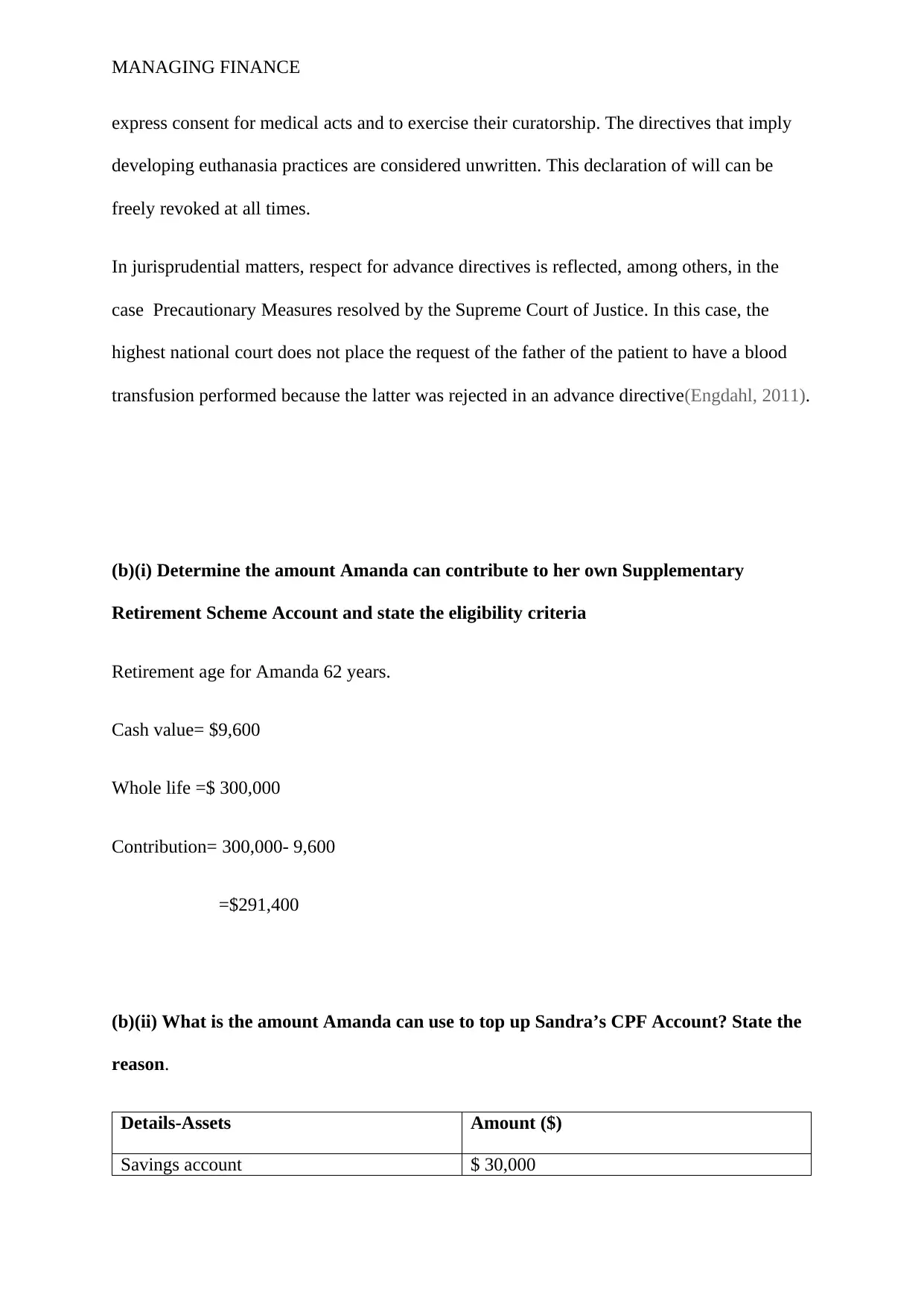
MANAGING FINANCE
express consent for medical acts and to exercise their curatorship. The directives that imply
developing euthanasia practices are considered unwritten. This declaration of will can be
freely revoked at all times.
In jurisprudential matters, respect for advance directives is reflected, among others, in the
case Precautionary Measures resolved by the Supreme Court of Justice. In this case, the
highest national court does not place the request of the father of the patient to have a blood
transfusion performed because the latter was rejected in an advance directive(Engdahl, 2011).
(b)(i) Determine the amount Amanda can contribute to her own Supplementary
Retirement Scheme Account and state the eligibility criteria
Retirement age for Amanda 62 years.
Cash value= $9,600
Whole life =$ 300,000
Contribution= 300,000- 9,600
=$291,400
(b)(ii) What is the amount Amanda can use to top up Sandra’s CPF Account? State the
reason.
Details-Assets Amount ($)
Savings account $ 30,000
express consent for medical acts and to exercise their curatorship. The directives that imply
developing euthanasia practices are considered unwritten. This declaration of will can be
freely revoked at all times.
In jurisprudential matters, respect for advance directives is reflected, among others, in the
case Precautionary Measures resolved by the Supreme Court of Justice. In this case, the
highest national court does not place the request of the father of the patient to have a blood
transfusion performed because the latter was rejected in an advance directive(Engdahl, 2011).
(b)(i) Determine the amount Amanda can contribute to her own Supplementary
Retirement Scheme Account and state the eligibility criteria
Retirement age for Amanda 62 years.
Cash value= $9,600
Whole life =$ 300,000
Contribution= 300,000- 9,600
=$291,400
(b)(ii) What is the amount Amanda can use to top up Sandra’s CPF Account? State the
reason.
Details-Assets Amount ($)
Savings account $ 30,000
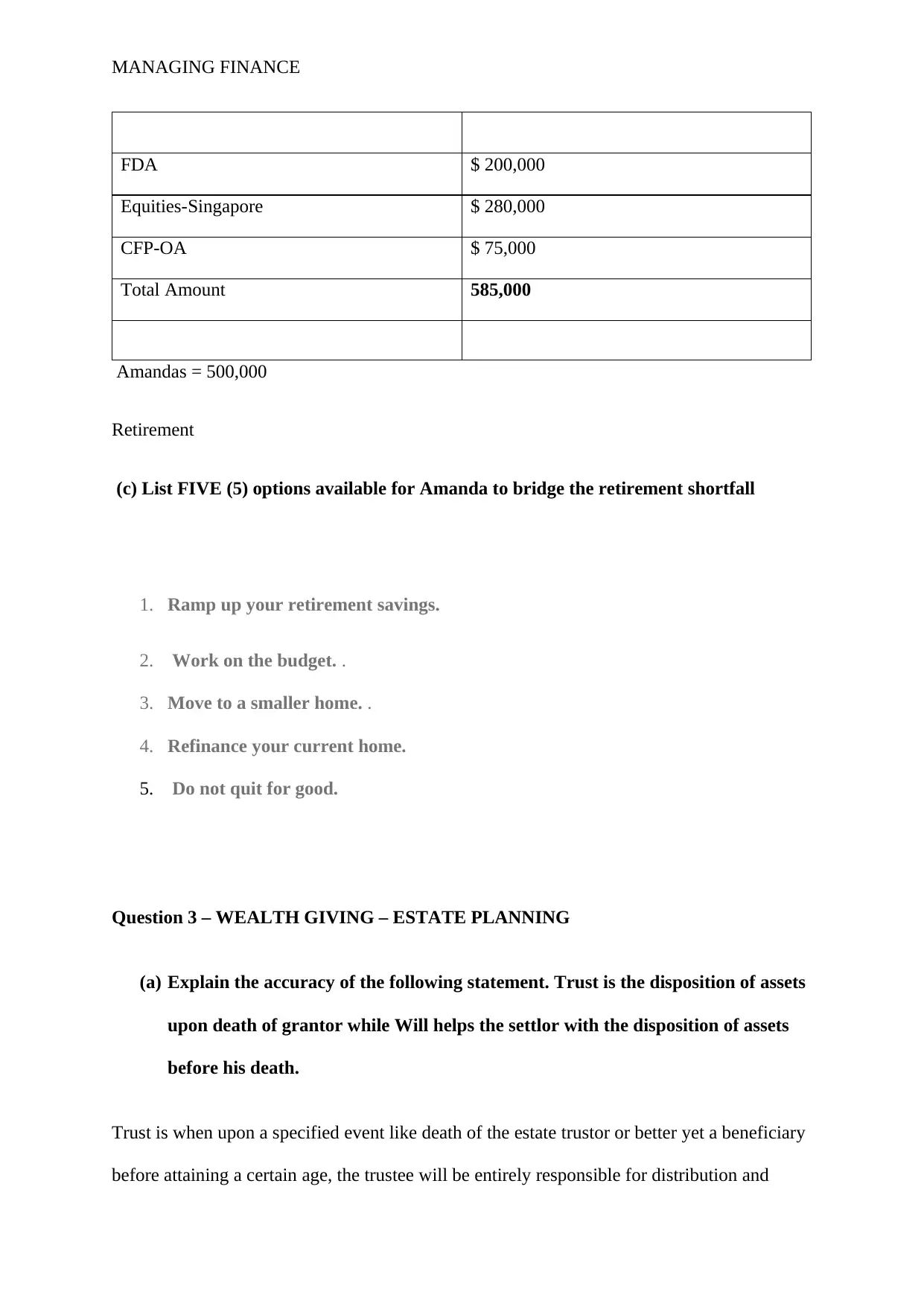
MANAGING FINANCE
FDA $ 200,000
Equities-Singapore $ 280,000
CFP-OA $ 75,000
Total Amount 585,000
Amandas = 500,000
Retirement
(c) List FIVE (5) options available for Amanda to bridge the retirement shortfall
1. Ramp up your retirement savings.
2. Work on the budget. .
3. Move to a smaller home. .
4. Refinance your current home.
5. Do not quit for good.
Question 3 – WEALTH GIVING – ESTATE PLANNING
(a) Explain the accuracy of the following statement. Trust is the disposition of assets
upon death of grantor while Will helps the settlor with the disposition of assets
before his death.
Trust is when upon a specified event like death of the estate trustor or better yet a beneficiary
before attaining a certain age, the trustee will be entirely responsible for distribution and
FDA $ 200,000
Equities-Singapore $ 280,000
CFP-OA $ 75,000
Total Amount 585,000
Amandas = 500,000
Retirement
(c) List FIVE (5) options available for Amanda to bridge the retirement shortfall
1. Ramp up your retirement savings.
2. Work on the budget. .
3. Move to a smaller home. .
4. Refinance your current home.
5. Do not quit for good.
Question 3 – WEALTH GIVING – ESTATE PLANNING
(a) Explain the accuracy of the following statement. Trust is the disposition of assets
upon death of grantor while Will helps the settlor with the disposition of assets
before his death.
Trust is when upon a specified event like death of the estate trustor or better yet a beneficiary
before attaining a certain age, the trustee will be entirely responsible for distribution and
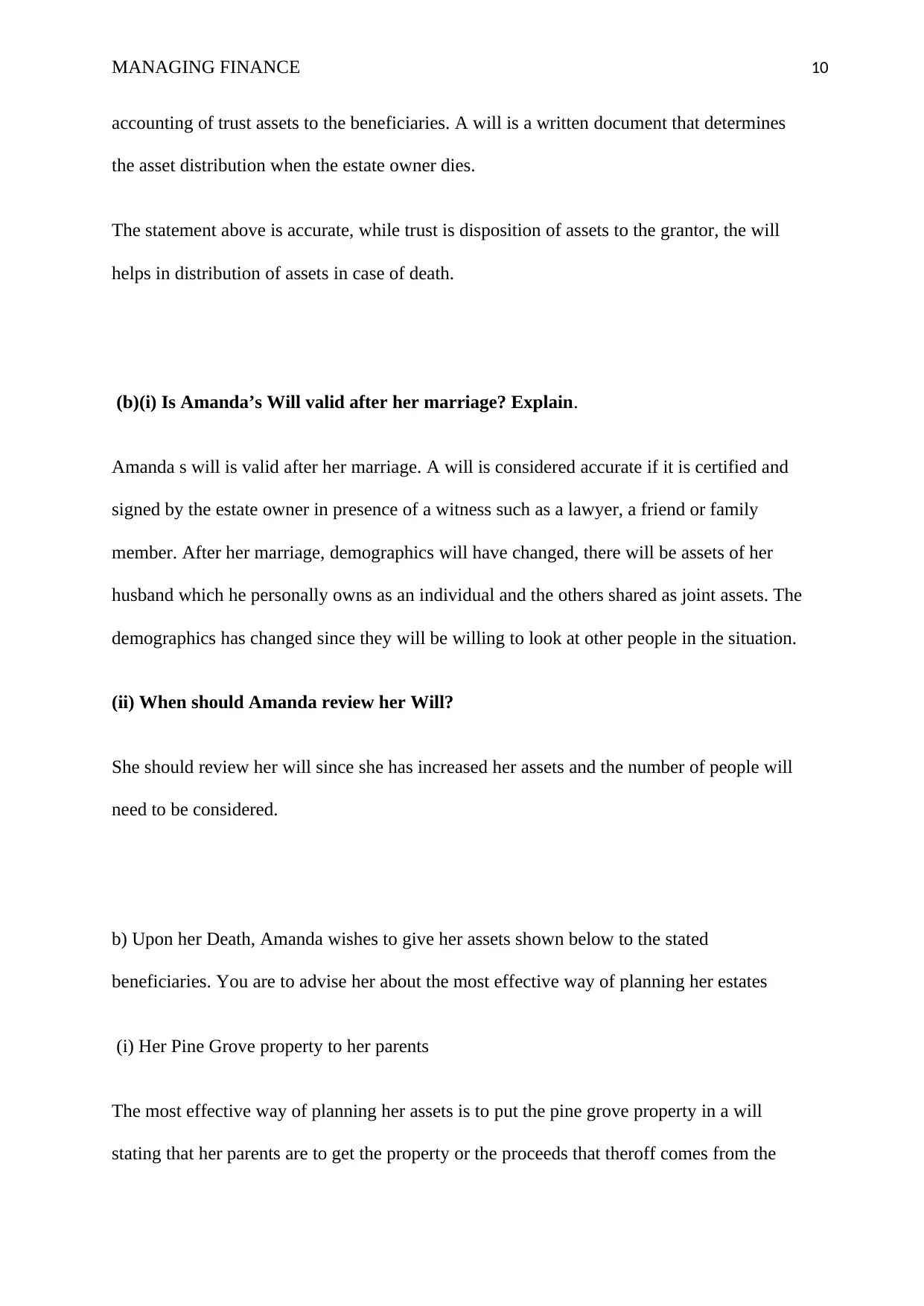
MANAGING FINANCE 10
accounting of trust assets to the beneficiaries. A will is a written document that determines
the asset distribution when the estate owner dies.
The statement above is accurate, while trust is disposition of assets to the grantor, the will
helps in distribution of assets in case of death.
(b)(i) Is Amanda’s Will valid after her marriage? Explain.
Amanda s will is valid after her marriage. A will is considered accurate if it is certified and
signed by the estate owner in presence of a witness such as a lawyer, a friend or family
member. After her marriage, demographics will have changed, there will be assets of her
husband which he personally owns as an individual and the others shared as joint assets. The
demographics has changed since they will be willing to look at other people in the situation.
(ii) When should Amanda review her Will?
She should review her will since she has increased her assets and the number of people will
need to be considered.
b) Upon her Death, Amanda wishes to give her assets shown below to the stated
beneficiaries. You are to advise her about the most effective way of planning her estates
(i) Her Pine Grove property to her parents
The most effective way of planning her assets is to put the pine grove property in a will
stating that her parents are to get the property or the proceeds that theroff comes from the
accounting of trust assets to the beneficiaries. A will is a written document that determines
the asset distribution when the estate owner dies.
The statement above is accurate, while trust is disposition of assets to the grantor, the will
helps in distribution of assets in case of death.
(b)(i) Is Amanda’s Will valid after her marriage? Explain.
Amanda s will is valid after her marriage. A will is considered accurate if it is certified and
signed by the estate owner in presence of a witness such as a lawyer, a friend or family
member. After her marriage, demographics will have changed, there will be assets of her
husband which he personally owns as an individual and the others shared as joint assets. The
demographics has changed since they will be willing to look at other people in the situation.
(ii) When should Amanda review her Will?
She should review her will since she has increased her assets and the number of people will
need to be considered.
b) Upon her Death, Amanda wishes to give her assets shown below to the stated
beneficiaries. You are to advise her about the most effective way of planning her estates
(i) Her Pine Grove property to her parents
The most effective way of planning her assets is to put the pine grove property in a will
stating that her parents are to get the property or the proceeds that theroff comes from the
Secure Best Marks with AI Grader
Need help grading? Try our AI Grader for instant feedback on your assignments.
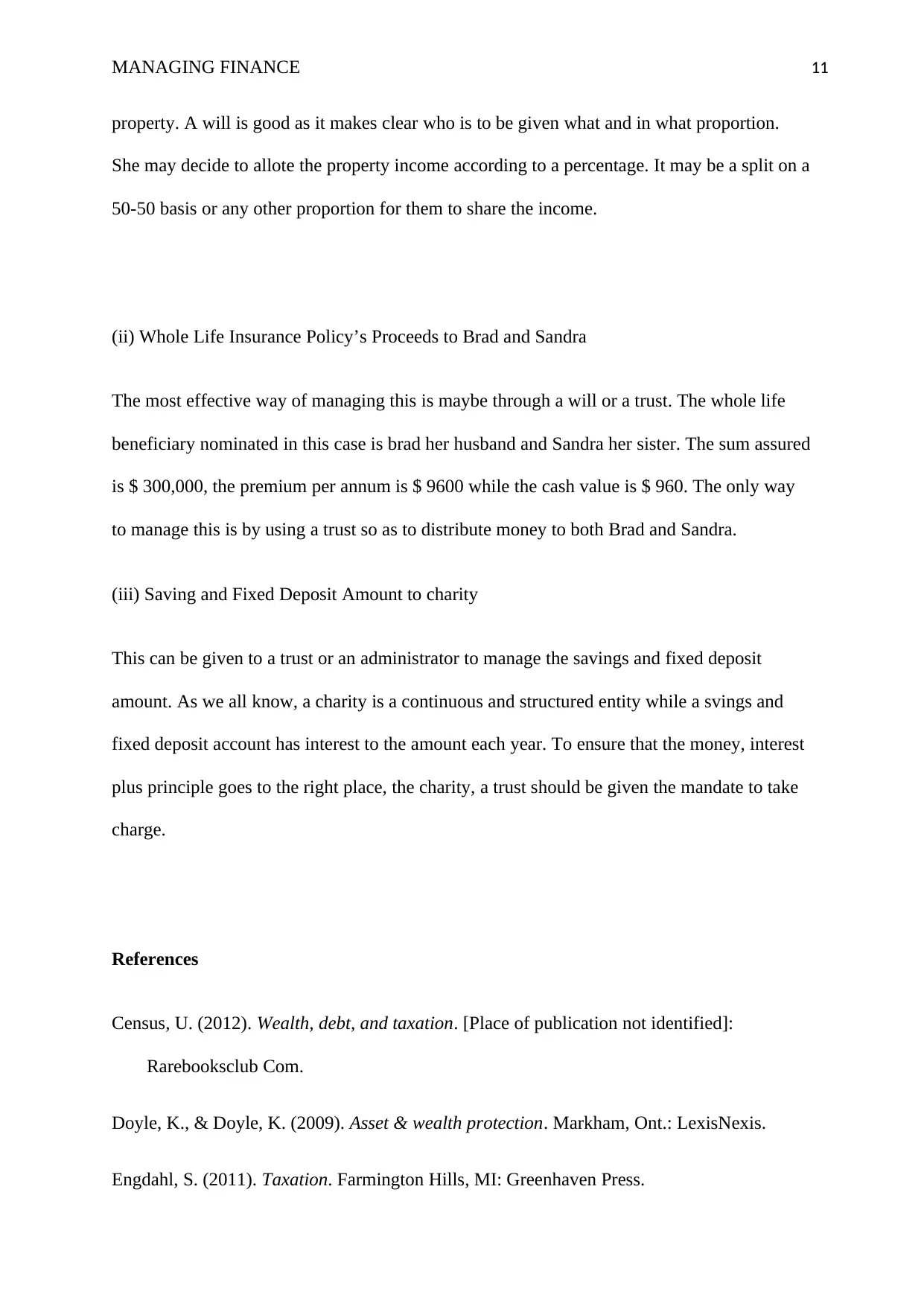
MANAGING FINANCE 11
property. A will is good as it makes clear who is to be given what and in what proportion.
She may decide to allote the property income according to a percentage. It may be a split on a
50-50 basis or any other proportion for them to share the income.
(ii) Whole Life Insurance Policy’s Proceeds to Brad and Sandra
The most effective way of managing this is maybe through a will or a trust. The whole life
beneficiary nominated in this case is brad her husband and Sandra her sister. The sum assured
is $ 300,000, the premium per annum is $ 9600 while the cash value is $ 960. The only way
to manage this is by using a trust so as to distribute money to both Brad and Sandra.
(iii) Saving and Fixed Deposit Amount to charity
This can be given to a trust or an administrator to manage the savings and fixed deposit
amount. As we all know, a charity is a continuous and structured entity while a svings and
fixed deposit account has interest to the amount each year. To ensure that the money, interest
plus principle goes to the right place, the charity, a trust should be given the mandate to take
charge.
References
Census, U. (2012). Wealth, debt, and taxation. [Place of publication not identified]:
Rarebooksclub Com.
Doyle, K., & Doyle, K. (2009). Asset & wealth protection. Markham, Ont.: LexisNexis.
Engdahl, S. (2011). Taxation. Farmington Hills, MI: Greenhaven Press.
property. A will is good as it makes clear who is to be given what and in what proportion.
She may decide to allote the property income according to a percentage. It may be a split on a
50-50 basis or any other proportion for them to share the income.
(ii) Whole Life Insurance Policy’s Proceeds to Brad and Sandra
The most effective way of managing this is maybe through a will or a trust. The whole life
beneficiary nominated in this case is brad her husband and Sandra her sister. The sum assured
is $ 300,000, the premium per annum is $ 9600 while the cash value is $ 960. The only way
to manage this is by using a trust so as to distribute money to both Brad and Sandra.
(iii) Saving and Fixed Deposit Amount to charity
This can be given to a trust or an administrator to manage the savings and fixed deposit
amount. As we all know, a charity is a continuous and structured entity while a svings and
fixed deposit account has interest to the amount each year. To ensure that the money, interest
plus principle goes to the right place, the charity, a trust should be given the mandate to take
charge.
References
Census, U. (2012). Wealth, debt, and taxation. [Place of publication not identified]:
Rarebooksclub Com.
Doyle, K., & Doyle, K. (2009). Asset & wealth protection. Markham, Ont.: LexisNexis.
Engdahl, S. (2011). Taxation. Farmington Hills, MI: Greenhaven Press.

MANAGING FINANCE 12
Jarvis, C., & Mandell, D. (2003). Wealth protection. Hoboken, N.J.: John Wiley & Sons.
Jarvis, C., & Mandell, D. (2003). Wealth protection. Hoboken, N.J.: John Wiley & Sons.
1 out of 12
Your All-in-One AI-Powered Toolkit for Academic Success.
+13062052269
info@desklib.com
Available 24*7 on WhatsApp / Email
![[object Object]](/_next/static/media/star-bottom.7253800d.svg)
Unlock your academic potential
© 2024 | Zucol Services PVT LTD | All rights reserved.

